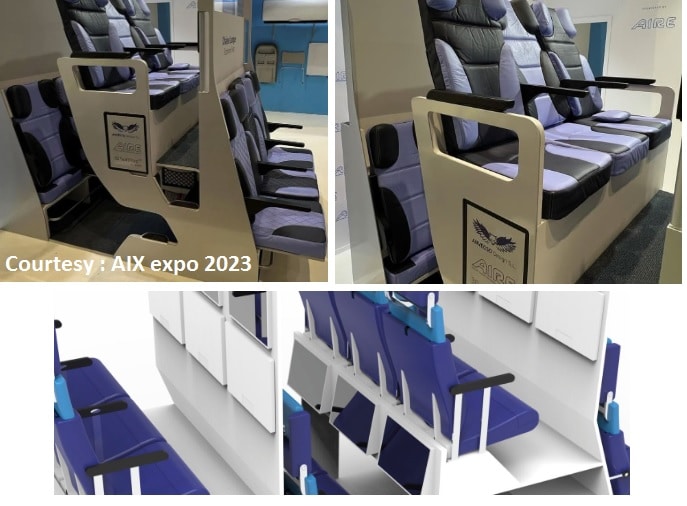Aerospace
Future Economy: The double-deck seats received a mixed response from online users.

One of the newly designed passenger aeroplane seats on display at the AIX Expo has grown more prominent, and it is this particular seat. Alejandro Nez Vicente, a 23-year-old designer of aeroplane seats, feels that the double-deck seat pattern concept is the future of commercial aviation.
The new approach to airline economy seats has caused quite a stir online. Sam Chui posted some photographs to his Twitter account, and many users immediately began joking about the absurd idea of locking passengers in an up-and-down position.
Airlines frequently request additional approvals to expand cabin space so they can accommodate a greater number of passengers and gradually lower flight prices for such places.
Nez Vicente claims that detractors have misread his goals when they claim that the design is all about airlines packing more seats on planes and potential passengers shudder at the prospect of claustrophobia.
The double-deck seating has received mixed responses from certain travellers.
Jerry user writes. I know we’re all “fascinated” with the “gas issues”…but what about the windows? One of those won’t have windows to lean against.
Ivan Coninxuser writes ” I don’t think this will work, for multiple reasons: 1) it’s not really ‘visible’, but basically you’re looking at another pax’s behind; 2) I don’t want to know how these seats will look like after hundreds of flights; 3) it appears to me that this concept in fact uses more space.
Jerry Frogett writes – Errrm… overhead lockers? Tray tables? ‘Upper deck’ can’t stretch out, or if they were able to then not without booting lower deck pax in the head… glad it is only a concept!
Most passengers have varied views to this and express concern about whether it will actually happen in the future. Most also claim that they will face penalties if they embark on long-haul flights while in such poor health. Others believe that the increased use of single-aisle flights will minimise carbon emissions.

Aerospace
Boeing Transfers Rocket Stage to NASA, Paving Way for Human Moon Mission

Boeing has achieved a significant milestone by providing NASA with the second core stage of the Space Launch System (SLS) rocket.
This crucial component, crafted at NASA’s Michoud Assembly Facility (MAF), is set to propel the Artemis II crew into lunar orbit, marking humanity’s return to deep space after a 50-year hiatus.
The monumental Boeing-built rocket stage, the largest element of the Artemis II mission, will embark on a journey aboard the Pegasus barge, traveling 900 miles to NASA’s Kennedy Space Center.
Comparison of two legendary aircraft B777x vs B747 aircraft:Click here
Upon arrival, it will be meticulously integrated with other essential Artemis II components, including the upper stage, solid rocket boosters, and NASA’s Orion spacecraft within the iconic Vehicle Assembly Building. This intricate integration process is a vital step toward the eagerly anticipated Artemis II launch, slated for 2025.
“Boeing-built products helped land humankind on the moon in 1969, and we’re proud to continue that legacy through the Artemis generation,” remarked Dave Dutcher, vice president and program manager for Boeing’s SLS program. “Together, with NASA and our industry partners and suppliers, we are building the world’s most capable rocket and paving the way to deep space through America’s rocket factory in New Orleans.”
NASA, Lockheed Martin Reveal X-59 Quiet Supersonic Aircraft:Click here
The delivery of Core Stage 2 marks a significant achievement in the evolution of the SLS rocket. Towering over 200 feet and powered by four RS-25 engines, this core stage, coupled with two solid-fueled booster rockets, will generate a staggering 8.8 million pounds of thrust. This immense power is crucial to launching Artemis II and future missions into the vast expanse of space.
The SLS rocket stands unparalleled in its capability to transport both crew and substantial cargo to the moon and beyond in a single launch. Its extraordinary capacity will facilitate the delivery of human-rated spacecraft, habitats, and scientific missions to destinations including the moon and Mars, ushering in a new era of space exploration.
-

 Travel1 week ago
Travel1 week agoAir India to Expand US Operations with Three New Routes After a Decade
-

 Travel2 weeks ago
Travel2 weeks agoWhy We Should Avoid These Stamps in a Passport
-

 Airlines1 month ago
Airlines1 month agoInvestigations Reveal Fake Chinese Titanium in Boeing and Airbus Jets
-

 Tech4 weeks ago
Tech4 weeks agoChina’s CATL Plans 1,800-Mile Electric Plane Launch by 2027
-

 Airport3 days ago
Airport3 days agoTop 10 Largest Airports in the World by Size
-

 Aerospace4 weeks ago
Aerospace4 weeks agoChina’s Fighter Jets Turn Wings into Autonomous Drones
-

 Airlines4 days ago
Airlines4 days agoAir India Rolls Out A350s for Delhi-New York JFK and Newark Routes
-

 Defence3 weeks ago
Defence3 weeks agoBoeing Enhances Chinook with New Engines and Block II Upgrades at $96 Million







